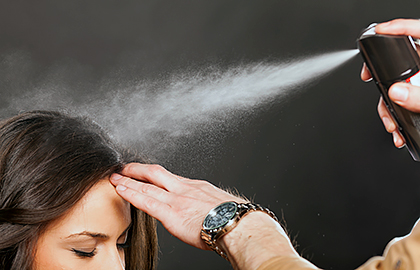Triggers could be causing your rosacea flare-ups

Anything that causes your rosacea to flare is called a trigger. Sunlight and hairspray are common rosacea triggers. Other common triggers include heat, stress, alcohol, and spicy foods.
Triggers differ from person to person.
Important to know what triggers your rosacea
Rosacea flares are more than a minor inconvenience. Each time your skin flushes, it can stay red a little longer. Rosacea may start to appear on more of your skin. In some people, repeated flushing leads to skin that stays permanently red. Visible blood vessels may start to appear. Skin can thicken.
With repeated flushing, treatment can also become more difficult. Treatment that may have worked earlier is no longer effective. Your dermatologist may need to prescribe stronger medicine or talk with you about an in-office treatment like laser therapy.
Knowing what triggers your flare-ups and making some simple changes can help you:
Reduce flares
Get better results from treatment
Prevent rosacea from worsening
This is why dermatologists often ask patients to find their triggers before beginning treatment. Even when treating rosacea, triggers can cause rosacea flare-ups.
You can find your own rosacea triggers by using the following 3-step process.
Step 1: Discover what could be triggering your rosacea
To find your triggers, you’ll have to do a bit of detective work. A good place to start is by looking at this list of common rosacea triggers. Do you think any could be causing your rosacea to flare?
Sunlight
Stress
Heat
Alcohol, especially red wine
Spicy foods
Some skin and hair care products
Some makeup
Wind and cold
Some medicines
Exercise
You may have other triggers. You’ll find a more extensive list of triggers at, Factors that may trigger rosacea flare-ups.
Step 2: Confirm your triggers
Now that you have an idea of what could be causing your rosacea flares, it’s time to gather the evidence. The National Rosacea Society offers an online form to help you do this.
Are you flushed?
If you’re not sure when your face turns red, ask a close friend or relative to let you know when you seem flushed.

The National Rosacea Society recommends that you:
Complete this form every day for at least 2 weeks.
Look at the items you checked on the form to see what coincides with your rosacea flares.
You’ll find the online form at, Rosacea diary booklet.
Another option is to keep a notebook. Write down what foods you eat, beverages you drink, personal care products you use, and things you are exposed to (like cold and heat) that could cause a rosacea flare-up.
Check your cheeks
Are you unsure when your face turns red? If your cheeks feel warm to the touch or you feel warm, you may be flushing.

You’ll also want to describe your rosacea symptoms, jotting down how serious they are.
Keeping track of these things for a few weeks (or months) can help you pinpoint what causes your flare-ups.
Step 3: Make some changes
Once you know what’s triggering your rosacea flares, taking action can help you avoid those triggers. The following article offers some simple solutions that can leave you feeling better without dramatically changing your life, How to prevent rosacea flare-ups.
Images
Getty Images
References
Crawford GH, Pelle MT, et al. “Rosacea: I. Etiology, pathogenesis, and subtype classification.” J Am Acad Dermatol2004;51:327-41.)
Pelle MT. “Rosacea.” In: Wolff K, Goldsmith LA, et al. Fitzpatrick’s Dermatology in General Medicine (seventh edition). McGraw Hill Medical, New York, 2008: 703-9.
Pelle MT, Glen H. Crawford GH, et al. “Rosacea: II. Therapy.” J Am Acad Dermatol 2004;51:499-512.
Steinhoff M, Schmelz M, et al. “Facial erythema of rosacea — Aetiology, different pathophysiologies, and treatment options. Acta Derm Venereol. 2016 Jun 15;96(5):579-86.
 Atopic dermatitis: More FDA-approved treatments
Atopic dermatitis: More FDA-approved treatments
 Biosimilars: 14 FAQs
Biosimilars: 14 FAQs
 How to trim your nails
How to trim your nails
 Relieve uncontrollably itchy skin
Relieve uncontrollably itchy skin
 Fade dark spots
Fade dark spots
 Untreatable razor bumps or acne?
Untreatable razor bumps or acne?
 Tattoo removal
Tattoo removal
 Scar treatment
Scar treatment
 Free materials to help raise skin cancer awareness
Free materials to help raise skin cancer awareness
 Dermatologist-approved lesson plans, activities you can use
Dermatologist-approved lesson plans, activities you can use
 Find a Dermatologist
Find a Dermatologist
 What is a dermatologist?
What is a dermatologist?